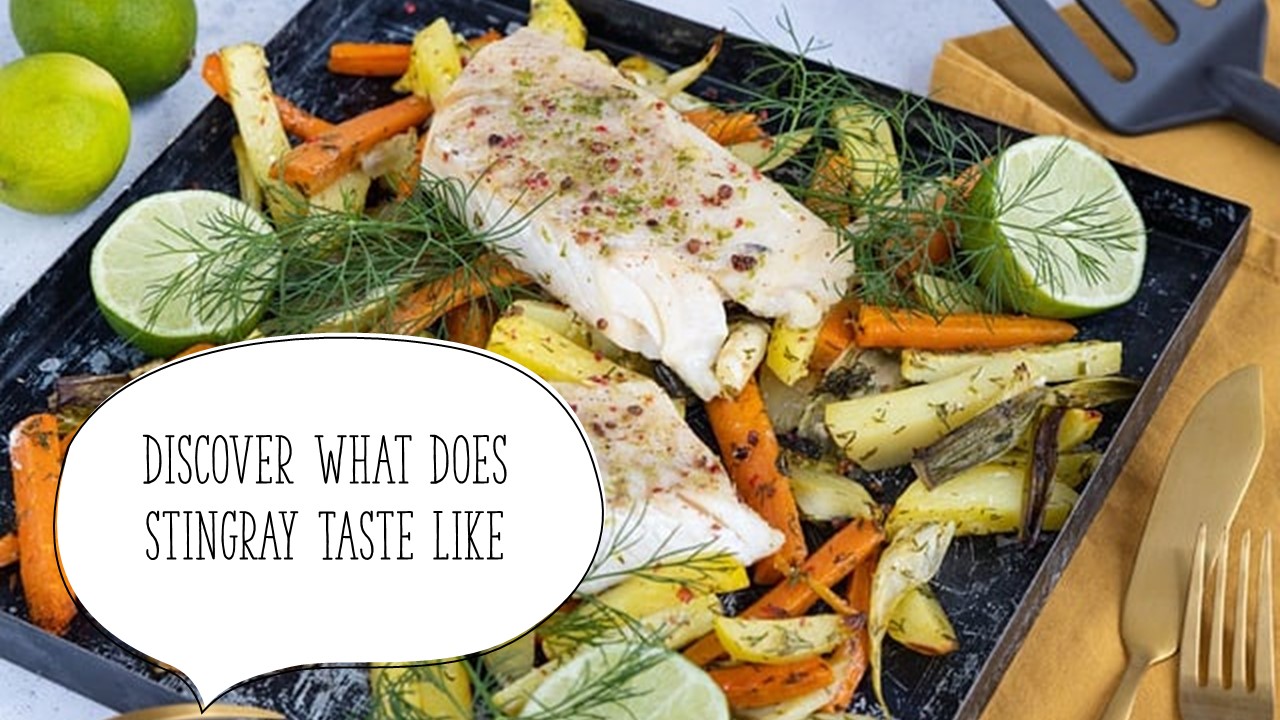Prepare your taste buds for a journey into the depths of flavor as I unravel the delectable secrets of stingray cuisine. Wondering what stingray tastes like? Picture a mild, slightly sweet flavor with a hint of brininess that dances on your palate. Its firm yet tender meat offers a delightful balance of textures, reminiscent of delicate fish varieties like flounder or skate. However, it’s worth noting that the flavor can vary slightly depending on the species of stingray and its habitat. Join me as I dive deeper into the enchanting world of stingray’s taste and discover the culinary wonders it holds.
In this post, I’ll delve into the topic of stingrays, exploring their physical characteristics, cultural significance, and most importantly, their taste. I’ll uncover the secrets of stingray’s flavor profile, discuss its texture and consistency, and even share some delectable recipes and cooking techniques. So, fasten your seatbelts and get ready for an underwater feast like no other!

Unveiling the Stingray: A Unique Culinary Experience
When it comes to unique marine creatures, stingrays certainly stand out. With their flat bodies, graceful movement, and long, whip-like tails, they captivate both marine enthusiasts and culinary explorers alike. Stingrays belong to the elasmobranch family, which includes sharks, and can be found in various coastal regions around the world. Their abundance makes them an intriguing and accessible ingredient for seafood lovers.
While some might be surprised to learn that stingrays are consumed as food, they have a long-standing history in culinary traditions across different cultures. From Asia to the Caribbean and beyond, these graceful creatures have found their way onto plates as a local delicacy. For instance, in Southeast Asian countries like Singapore and Malaysia, stingray is a popular street food item often served with sambal sauce or char-grilled to perfection. Exploring the cultural significance of stingrays in various cuisines adds an extra layer of fascination to the dining experience.
Join me in the next section as I embark on a sensory adventure and explore the tantalizing taste, texture, and aroma of stingray meat.
Tasting Stingray: Flavor, Texture, and Aroma
Now, let’s talk about the star of the show—the flavor of stingray meat. Stingray offers a delightful and distinctive taste that sets it apart from other seafood options. When cooked, it exhibits a mildly sweet flavor with a hint of brininess, reminiscent of the ocean. The taste can be compared to that of other delicate fish varieties such as flounder or skate. However, it’s important to note that the flavor may vary slightly depending on the species of stingray and its habitat.
Texture plays a crucial role in our culinary experiences, and stingray does not disappoint. The meat is firm yet tender, providing a pleasant bite that is not too tough nor overly delicate. It holds its shape well during cooking, making it a versatile ingredient for various preparations. When properly cooked, stingray meat achieves a perfect balance between flakiness and a meaty, substantial texture, making each bite a delightful experience.
Before cooking, raw stingray emits a slightly briny scent that is characteristic of many seafood ingredients. However, once cooked, the aroma transforms into a more appetizing and enticing fragrance. Grilled stingray, for example, releases a wonderful smoky aroma that whets the appetite. The cooking process enhances the natural flavors and imparts a captivating scent that adds to the overall sensory experience.
Preparing Stingray: Best Cooking Methods and Flavor Pairings
Essential Tips and Techniques Now that we’ve discovered the tantalizing flavors of stingray, it’s time to learn how to prepare it for a truly unforgettable culinary experience. Here are some essential tips and techniques to ensure your stingray dishes turn out perfectly:
- Cleaning and Filleting: Start by thoroughly cleaning the stingray, removing the skin, cartilage, and any residual blood. Fillet the meat carefully, ensuring you remove any tough membranes or excess fat.
- Marinating: Stingray benefits from marinating to enhance its flavor. Consider using a marinade that includes a combination of citrus, herbs, and spices to complement its delicate taste.
Popular Stingray Recipes
Now that your stingray is prepped and ready, let’s explore some popular cooking methods to bring out its best qualities:
- Grilling: Grilled stingray is a favorite among seafood enthusiasts. Brush the fillets with marinade and grill them over medium heat until they are cooked through, with a slight char on the outside. This method imparts a smoky flavor that perfectly complements the natural sweetness of the meat.
- Baking: For a hassle-free cooking option, baking stingray in the oven is a great choice. Place the fillets on a baking sheet, brush them with marinade or olive oil, and bake at a moderate temperature until they are cooked and flaky.
- Pan-frying: Pan-frying stingray allows you to achieve a crispy exterior while retaining the tenderness of the meat. Heat a little oil in a pan, season the fillets, and cook them on each side until they are golden brown and cooked through.
Flavor Pairings to Enhance Stingray’s Taste
Stingray has a subtle flavor that pairs well with a variety of ingredients. Here are some flavorful combinations to take your stingray dishes to the next level:
- Citrus Zest: The bright and tangy notes of citrus, such as lemon or lime zest, add a refreshing kick to stingray. Sprinkle some zest over the cooked fillets to awaken the flavors.
- Spices and Herbs: Stingray welcomes the addition of herbs and spices. Experiment with flavors like garlic, thyme, paprika, or chili powder to add depth and complexity to your dishes.
- Tangy Sauces: Stingray pairs beautifully with tangy sauces like a zesty lemon butter sauce or a spicy sambal sauce. These sauces cut through the richness and enhance the natural flavors of the meat.
In the next section, I’ll uncover some fantastic places where you can enjoy stingray dishes and indulge in the full stingray culinary experience!
The Stingray Experience: Where to Find and Enjoy Stingray Dishes
If you’re eager to savor the magic of stingray without the hassle of cooking it yourself, there are several destinations renowned for their incredible stingray culinary offerings. Here are a few places to add to your foodie bucket list.
- Southeast Asia: Countries like Singapore, Malaysia, and Thailand boast vibrant street food scenes where you can find mouthwatering stingray dishes. Hawker centers and night markets are excellent places to sample grilled or barbecued stingray served with spicy sambal sauce.
- Caribbean Islands: In the Caribbean, particularly in places like Barbados and Trinidad and Tobago, stingray is a local specialty. Look for beachside shacks and seafood restaurants that serve fresh and flavorful stingray preparations, often accompanied by local spices and seasonings.
Stingray as a Local Specialty
When traveling to a new destination, immersing yourself in the local food culture is a must. Stingray, being a local specialty in many places, offers a unique opportunity to explore the flavors of the region. Here are a few examples:
- Malaysian Rojak: In Malaysia, stingray is sometimes featured as an ingredient in rojak, a popular fruit and vegetable salad. The meat is sliced thinly, marinated, and added to the mix of crisp fruits and veggies, creating a harmonious blend of flavors.
- Singaporean Barbecue Stingray: Singaporeans take pride in their barbecued stingray, also known as “sambal stingray.” The fillets are grilled to perfection, slathered with a spicy sambal sauce, and served with a side of fragrant rice or crusty bread.
Whether you’re traveling or simply looking for a unique dining experience in your own city, keep an eye out for restaurants, seafood shacks, or food festivals that feature stingray on their menus. Exploring local specialties is not only a gastronomic adventure but also a chance to embrace the culture and traditions associated with this extraordinary seafood.
Conclusion
As I wrap up this guide on what stingray taste like, you unveil a seafood gem with a mild, slightly sweet flavor, accompanied by a subtle brininess. Its firm yet tender texture, reminiscent of delicate fish like flounder or skate, adds to the overall culinary experience.
While variations in flavor may exist among different stingray species and habitats, the undeniable charm of this unique seafood delicacy remains. Whether you’re grilling, baking, or pan-frying, stingray promises a delightful balance of flavors and textures that will leave you craving more.
I hope this journey into the world of stingray cuisine has piqued your curiosity and inspired you to embark on your own flavorful adventure. Don’t hesitate to share your own stingray experiences and thoughts in the comments below. Happy exploring and enjoying the unique tastes of stingrays!
Your Next Read: Can You Really Eat Saltwater Catfish? Unveiling The Truth




